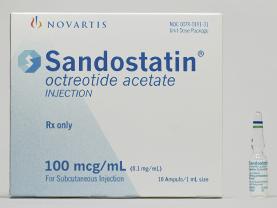Sandostatin Dosage
Generic name: OCTREOTIDE ACETATE 50ug in 1mL
Dosage form: injection, solution
Drug class: Somatostatin and somatostatin analogs
Medically reviewed by Drugs.com. Last updated on Aug 11, 2025.
2.1 Dosage and Administration Overview
- Sandostatin Injection may be administered subcutaneously or intravenously. Pain with subcutaneous administration may be reduced by using the smallest volume that will deliver the desired dose. Sites should be rotated in a systematic manner.
- Parenteral drug products should be inspected visually for particulate matter and discoloration prior to administration. Do not use if particulates and/or discoloration are observed. Sandostatin Injection is not compatible in Total Parenteral Nutrition solutions because of the formation of a glycosyl octreotide conjugate which may decrease the efficacy of the product.
- Sandostatin Injection may be diluted in volumes of 50 mL to 200 mL and infused intravenously over 15 to 30 minutes or administered by intravenous (IV) push over 3 minutes. In emergency situations (e.g., carcinoid crisis), it may be given by rapid bolus.
- Assess total and/or free T4 levels at baseline and periodically during chronic Sandostatin therapy.
2.2 Recommended Dosage and Monitoring for Acromegaly
The recommended initial dosage of Sandostatin is 50 mcg three times daily to be administered subcutaneously. Increase Sandostatin dose based upon GH or IGF-1 levels. The goal is to achieve GH levels less than 5 ng/mL or IGF-1 levels within normal range. Monitor GH or IGF-1 every two weeks after initiating Sandostatin therapy or with dosage change, and to guide titration.
The most common dosage is 100 mcg three times daily, but some patients require up to 500 mcg three times daily for maximum effectiveness. Doses greater than 300 mcg/day seldom result in additional biochemical benefit, and if an increase in dose fails to provide additional benefit, the dose should be reduced.
Sandostatin Injection should be withdrawn yearly for approximately 4 weeks from patients who have received irradiation to assess disease activity. If GH or IGF-1 levels increase and signs and symptoms recur, Sandostatin Injection therapy may be resumed.
2.3 Recommended Dosage and Monitoring for Carcinoid Tumors
The recommended daily dosage of Sandostatin Injection during the first 2 weeks of therapy ranges from 100 to 600 mcg/day in two to four divided doses given subcutaneously (mean daily dosage is 300 mcg). In the clinical studies, the median daily maintenance dosage was approximately 450 mcg, but clinical and biochemical benefits were obtained in some patients with as little as 50 mcg, while others required doses up to 1500 mcg/day. However, experience with doses above 750 mcg/day is limited. Measurement of urinary 5-hydroxyindole acetic acid, plasma serotonin, plasma Substance P may be useful in monitoring the progress of therapy.
2.4 Recommended Dosage and Monitoring for Vasoactive Intestinal Peptide Tumors
Daily dosages of 200 mcg to 300 mcg in two to four divided doses given subcutaneously are recommended during the initial 2 weeks of therapy (range, 150 mcg to 750 mcg) to control symptoms of the disease. On an individual basis, dosage may be adjusted to achieve a therapeutic response, but usually doses above 450 mcg/day are not required. Measurement of Plasma vasoactive intestinal peptide (VIP) may be useful in monitoring the progress of therapy.
Frequently asked questions
- Is Sandostatin a chemotherapy drug?
- How is Sandostatin given/administered?
- How does Sandostatin work for GI bleeds?
- Does Sandostatin shrink or slow tumor growth?
More about Sandostatin (octreotide)
- Check interactions
- Compare alternatives
- Pricing & coupons
- Reviews (7)
- Drug images
- Latest FDA alerts (1)
- Side effects
- During pregnancy
- Generic availability
- Drug class: somatostatin and somatostatin analogs
- Breastfeeding
- En español
Patient resources
Other brands
Professional resources
Other brands
Other formulations
Related treatment guides
See also:
Further information
Always consult your healthcare provider to ensure the information displayed on this page applies to your personal circumstances.


